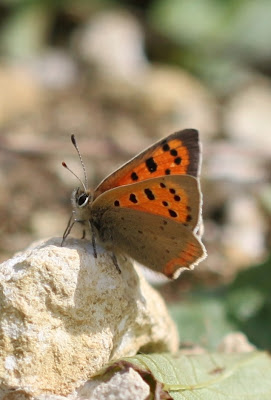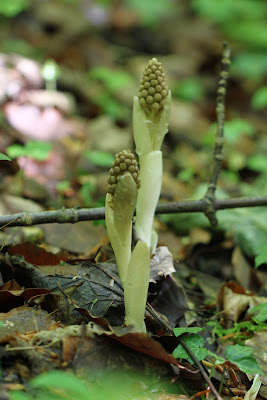Having seen our Robin's nest ripped apart earlier in the Spring , we were sure that they had nested again within 1 or 2 gardens of ours , but never found where . This morning whilst having breakfast ,
this little chap came for a drink from the birdbath on the patio , great start to the day . With grey skies and rain approaching by lunchtime , I decided not to venture too far , so headed for Kelsey Park in Beckenham , even though it is half term . The weather seemed to have put many off as even dog walkers were few on my arrival . I made straight for the large London Plane tree , to see if my prediction of the Nuthatch being on eggs was right , when nothing was seen last visit . It didn't take
long after setting up the tripod that the first parent was seen , with a bill full of goodies . It soon became obvious that both birds were working hard , seemingly one foraging on either side of the
tree . Of course , every action has a reaction , not sure who said that , or whether I just made it up ,
but it wasn't one way traffic with the food . Sometimes when the adults left the nest hole , they launched themselves into the air , only needing a coiled spring behind them to resemble a Cuckoo on
a Swiss clock . Although they didn't make a sound coming or going , the constant movement attracted the attention of a predator . The last time I photographed the nest hole , a Great Spotted Woodpecker
attempted to get into the nest , this time it was a Magpie . At the time , the right hand bird had just entered the nest and even though the other bird was going berserk , the Magpie took no notice . I decided to shoo off the Magpie , but it didn't go far , so I moved it on again . It was some considerable time after that before the bird came out and the other entered with it's food . Apart from the Nuthatch , this tree also has a Jackdaw and a minimum of three Rose-ringed Parakeet nests . I left
the Nuthatches to it and found several Coot families , all with very young broods . Only one Grey Wagtail was seen this visit , hopefully the other one is on eggs . The usual duck species were seen , with nothing unusual , unless you count the strange Muscovy Duck , this one having to find natural
food , there being no families with loaves around . In the same area , a Grey Squirrel looks as if it was
practising it's audition for Fagin in Oliver . I mentioned earlier the abundance of RRP nests , and this was confirmed when 25/30 flew over the lake , noisily of course . I managed to get 9 in the
viewfinder together , and with several with short tail feathers , think this could be flying practice for new arrivals . There will probably be many more flying lessons , especially if these two have their way . The one on the left had just come out of a hole , and I think the one on the right was telling
what the other one's eyes reminded it of , well , for starters anyway . With not much else around , I set up the tripod across the lake from the most open Grey Heron nest and once again waited and
hoped that an adult would fly in with food for the brood , which by the size of them , must be almost ready to fledge . Needless to say , another failure , but hopefully one day it will work out . To fill in the time , and in deteriorating light conditions , I played 'try and get one of the 6 Swifts that were
around , into the viewfinder' . A couple of times , the odd bird swooped low over the water , but then the AF struggled to work with a busy background of trees etc . So I had to settle for long distance
shots against a grey sky , what I would have given for just 5 minutes of decent light . I seem to remember saying the same after try to photograph the Swallows over the lake on my last visit . I was
pleased when a juvenile Herring Gull made a slower , lower fly past , much easier to get in the viewfinder . Very shortly after taking this shot , the first spots of rain started and it was time to get the gear under cover and call it a day .
Since then it's been on and off drizzle and cold , and I've been keeping an eye on the back garden at irregular intervals . One look turned up trumps , when two juvenile Robins and two adults were seen ,
and even luckier when I got this shot , albeit through double glazing . Last shot of the day was of
what we call 'our Jackdaw' , as it is easily recognised and clears up loose seed like a hoover .
4 hours ago









































.JPG)











